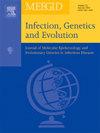Study of genetic diversity of Echinococcus granulosus sensu stricto in France based on full cox1 gene
IF 2.6
4区 医学
Q3 INFECTIOUS DISEASES
引用次数: 0
Abstract
Cystic echinococcosis (CE) is a worldwide zoonosis caused by Echinococcus granulosus sensu lato (s.l.) complex with E. granulosus sensu stricto (s.s.) the main species responsible of humans CE. This study highlights the genetic diversity of E. granulosus s.s. in France to clarify the parasite's circulation in livestock, interactions with wildlife, and distinguish autochthonous from imported cases of human CE. A total of 129 full cox1 gene sequences were obtained: 101 from livestock, 12 from wildlife, and 16 from human CE patients operated in France. This study reveals a broad genetic diversity of E. granulosus s.s. in France and little differentiation between sheep and cattle parasite populations, or between geographic areas. The G3 genotype (67 %) was predominant, mainly in sheep from the Alps, a historical focus in Southeast France. Despite farms being less than 20 km apart, no common haplotype was found, suggesting separate infections sources, without excluding the potential role of transhumance in parasite transmission. Haplotypes shared by livestock and wolves remain insignificant in maintaining the life cycle given the low occurrence of infection in wolves. Concerning the 16 cases of human CE, full cox1 haplotypes provide additional genetic argument supporting their status as mainly imported cases. Nevertheless, as autochthonous human cases have already been reported, further genetic characterization of E. granulosus s.s. in both humans and livestock in France is important to identify epidemiologic links and develop action plans to prevent and control this parasite.

基于全cox1基因的法国狭义细粒棘球绦虫遗传多样性研究
囊性棘球绦虫病是一种世界性的人畜共患病,由细粒棘球绦虫(细粒棘球绦虫)和细粒棘球绦虫(细粒棘球绦虫)复合引起,是人类囊性棘球绦虫的主要致病种。本研究强调了法国颗粒棘球绦虫的遗传多样性,以阐明该寄生虫在牲畜中的传播、与野生动物的相互作用,并区分本地和输入的人类棘球绦虫病例。共获得129个完整的cox1基因序列:101个来自牲畜,12个来自野生动物,16个来自法国手术的人类CE患者。这项研究揭示了法国颗粒棘球绦虫具有广泛的遗传多样性,而绵羊和牛寄生虫种群之间或地理区域之间的差异很小。G3基因型占主导地位(67%),主要在阿尔卑斯山的绵羊中,阿尔卑斯山是法国东南部的历史焦点。尽管农场之间的距离不到20公里,但没有发现共同的单倍型,这表明有不同的感染源,但不排除在寄生虫传播中转运的潜在作用。由于狼的感染发生率较低,牲畜和狼共有的单倍型在维持生命周期方面仍然微不足道。对于16例人类CE病例,完整的cox1单倍型提供了额外的遗传学论据,支持其主要为输入病例的地位。尽管如此,由于已经报告了本地人类病例,因此进一步对法国人类和牲畜中的颗粒棘球绦虫进行遗传鉴定对于确定流行病学联系并制定预防和控制该寄生虫的行动计划具有重要意义。
本文章由计算机程序翻译,如有差异,请以英文原文为准。
求助全文
约1分钟内获得全文
求助全文
来源期刊

Infection Genetics and Evolution
医学-传染病学
CiteScore
8.40
自引率
0.00%
发文量
215
审稿时长
82 days
期刊介绍:
(aka Journal of Molecular Epidemiology and Evolutionary Genetics of Infectious Diseases -- MEEGID)
Infectious diseases constitute one of the main challenges to medical science in the coming century. The impressive development of molecular megatechnologies and of bioinformatics have greatly increased our knowledge of the evolution, transmission and pathogenicity of infectious diseases. Research has shown that host susceptibility to many infectious diseases has a genetic basis. Furthermore, much is now known on the molecular epidemiology, evolution and virulence of pathogenic agents, as well as their resistance to drugs, vaccines, and antibiotics. Equally, research on the genetics of disease vectors has greatly improved our understanding of their systematics, has increased our capacity to identify target populations for control or intervention, and has provided detailed information on the mechanisms of insecticide resistance.
However, the genetics and evolutionary biology of hosts, pathogens and vectors have tended to develop as three separate fields of research. This artificial compartmentalisation is of concern due to our growing appreciation of the strong co-evolutionary interactions among hosts, pathogens and vectors.
Infection, Genetics and Evolution and its companion congress [MEEGID](http://www.meegidconference.com/) (for Molecular Epidemiology and Evolutionary Genetics of Infectious Diseases) are the main forum acting for the cross-fertilization between evolutionary science and biomedical research on infectious diseases.
Infection, Genetics and Evolution is the only journal that welcomes articles dealing with the genetics and evolutionary biology of hosts, pathogens and vectors, and coevolution processes among them in relation to infection and disease manifestation. All infectious models enter the scope of the journal, including pathogens of humans, animals and plants, either parasites, fungi, bacteria, viruses or prions. The journal welcomes articles dealing with genetics, population genetics, genomics, postgenomics, gene expression, evolutionary biology, population dynamics, mathematical modeling and bioinformatics. We also provide many author benefits, such as free PDFs, a liberal copyright policy, special discounts on Elsevier publications and much more. Please click here for more information on our author services .
 求助内容:
求助内容: 应助结果提醒方式:
应助结果提醒方式:


